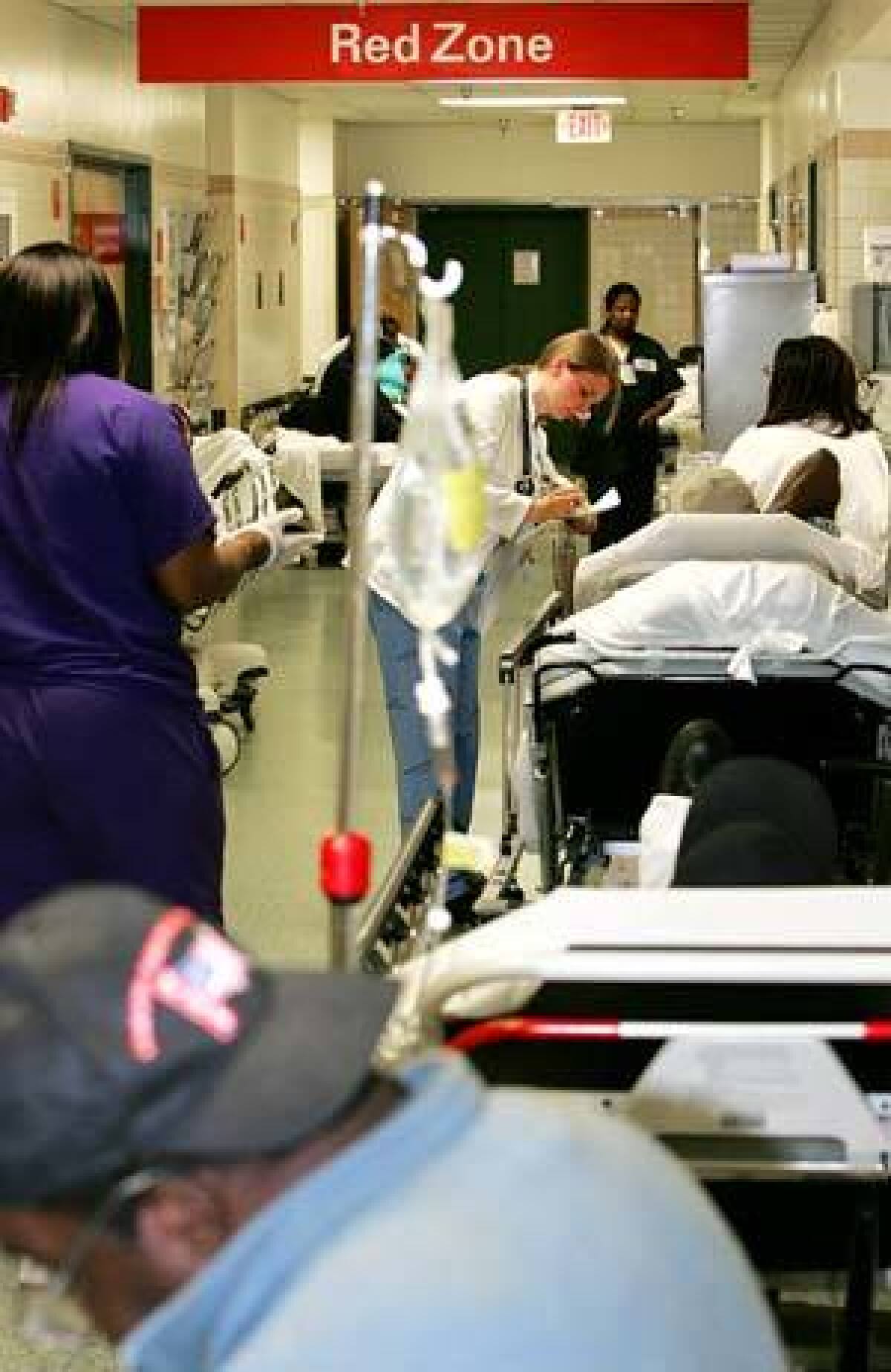Hospital and nursing home complaints have an ear

- Share via
With hospitals and nursing homes tending to thousands of patients every year, accidents can — and do — happen. These incidents, whether through carelessness or otherwise, can leave patients feeling powerless. That’s not the case.
“There is growing public awareness, people are feeling more empowered, and they have tools at their disposal to make a complaint,” said Ralph Montano, spokesman for the California Department of Public Health, which regulates hospitals and long-term care facilities in the state.
That department received more than 6,000 complaints about hospitals in 2007, the most recent year for which statistics are available. The complaints can be about mixed-up lab results, medication errors, foreign objects left in a patient during surgery or a host of other topics.
Similarly, the California Department of Aging received 43,000 nursing home complaints in 2009. Some alleged patient abuse or neglect; others reported missing items. And some commented on the quality of the food.
But finding the channels through which to lodge a complaint can be tedious and time consuming. Many consumers simply don’t bother, and some become lost in the system. Whether the complaint is against a hospital or a long-term care facility, the process is similar — and many people can help, including the facility’s staff, insurance company representatives and state regulators.
Here’s how to complain.
In-house
Most patient advocates recommend first talking with providers within the hospitals and nursing homes. Many organizations prefer to resolve problems at the point of care.
If you want to make a complaint while in the hospital, Patti Harvey, vice president of quality and patient care services for Kaiser Permanente in Southern California, recommends talking with the bedside nurse at a facility.
If that doesn’t work, you can talk with other people higher in the chain of command, up to the hospital administrator.
If the problem still isn’t taken care of — say you disagree with your treatment plan or have a problem with your doctor — member service offices at each hospital can help address your concerns.
UCLA Health System hospitals have similar offices to resolve complaints or grievances, said Virgie Mosley, manager of patient affairs for the health system. When you or a family member contacts the patient affairs office, the chair of the clinical team responsible for that unit reviews your records. The hospital will then provide a written response to you or schedule a conference.
Insurers
If you want to wait until after you leave the facility’s walls to complain, one option is to file with your insurance company. The California Department of Managed Health Care requires that insurers in the state have a written process for patient complaints about hospitals and nursing homes.
Aetna members, for example, can call the Aetna Member Services number on their identification card and speak with a staff member. The company’s agents take preliminary information, which is entered into the company’s computer system. Often complaints can also be filed with insurers online.
“We are especially interested when they have a quality-of-care or service concern,” said Terri Schroeder, head of regional quality for Aetna Inc. “We want to do everything possible to make sure patients are getting the care they need and deserve.”
Quality-of-care complaints are sent to Schroeder’s department, staffed by registered nurses, for clinical review. For minor issues, such as long wait times or out-of-service equipment, the company tracks the complaints, looks for patterns and may work with the facility if it becomes a trend.
For an event that is life-threatening or poses imminent danger for a patient (for example, a family finds there is not sufficient staff on a patient on suicide watch), Aetna’s staff will try to help resolve the issue immediately. If a patient has left a facility, Aetna collects medical records, which go through a review process by trained medical professionals. This is typically a 30-day process.
If a facility is found to be at fault, Aetna can request a corrective action or even terminate the institution’s contract. Though the details of the investigation are confidential, members can call in to find out whether the problem has been resolved.
Joint commission
The Joint Commission on Accreditation of Healthcare Organizations is a not-for-profit agency that accredits and certifies more than 17,000 healthcare organizations and institutions such as hospitals, nursing homes, behavioral health facilities and clinical laboratories nationwide. The commission’s Office of Quality Monitoring evaluates complaints filed against accredited organizations relating to care and safety issues.
Complaints can be faxed, phoned, e-mailed or mailed to the Joint Commission (see related story for contact information). When filing a complaint, briefly summarize the issues and provide the name and address of the facility. The agency takes one of four actions, depending on the complaint’s severity. The healthcare facility may be asked to provide a written response to the allegation. The complaint may be reviewed and considered during a coming survey. It may be placed in a database used to track performance. And if there is a serious threat to patient safety, a staff member will conduct a surprise visit to the organization.
Verified complaints can result in actions from resolution of the problem to denial of accreditation.
Ombudsman
The California State Long Term Care Ombudsman Program can help resolve problems at nursing homes. It’s the arm of the state’s Department of Aging that investigates complaints made against long-term care facilities.
There are 35 offices in the state, staffed with ombudsman representatives who advocate for residents of the 1,200 nursing homes and almost 8,000 residential homes in California.
When a complaint is received, an ombudsman from a nearby office goes to the facility to investigate within two to three days, said Joe Rodrigues, the state long-term care ombudsman. If the facility takes action, the case is considered resolved.
If there is no resolution or if the problem is about neglect or abuse, the ombudsman will bring it to the attention of the California Department of Public Health, which regulates nursing homes and hospitals. But most of the time, ombudsman representatives are able to take care of issues that come to their attention.
“We are able to resolve three out of every four complaints brought to us fully or partially,” Rodrigues said. “That is a testament to the kind of advocacy we engage in.”
State regulators
If you are filing a complaint with your local ombudsman, file one with the Department of Public Health for good measure, recommends Pat McGinnis, executive director of California Advocates for Nursing Home Reform.
The department’s staff responds within 24 hours to severe complaints and within 10 business days for minor complaints. When a facility is found to be at fault, the department can issue fines, deficiencies or revoke Medicare and Medi-Cal funding. Documentation of substantiated complaints is available at district offices.
If the complaint is found to be unsubstantiated, you can request an informal conference with a district manager. You must request the conference within five days of the decision, and it will be scheduled within 30 days. The district manager’s staff will render a decision within 10 business days after the conference.
One final appeal can be made within 15 days of the conference if you are unsatisfied with the decision. The deputy director’s staff will review the case and make a final determination within 30 days.
Recommended information to include in any complaint is the name and address of the facility and your contact information (if you choose to provide it), the date and time of the incident, specific details, names of witnesses and relevant staff, and any useful records.
McGinnis recommends filing complaints even if it seems to be a minor issue, such as unfilled water pitchers in a nursing home (this could lead to patient dehydration).
“If this is something that happens a lot, it is something that may be going on with everyone,” she said. “We want people to look at systemic problems, because it is not just your mom, but it is probably happening to others who don’t have advocates as well.”
For contact information for the above agencies, see related story.






